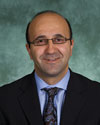How the approach to periprosthetic joint infection has evolved
Click Here to Manage Email Alerts

Each year, one of the most important components of the EFORT Congress is the presence of an outstanding orthopaedic surgeon with international reputation who contributes to our scientific program by giving the Erwin Morscher Honorary Lecture. This plenary session is scheduled for Thursday, 6 June 2019, just before the lunch break, to gather the biggest audience of all the scientific sessions. This year, EFORT is pleased to welcome Javad Parvizi, MD, FRCS, a native of Azerbaijan, Iran, who is currently practicing at Rothman Orthopaedic Institute in Philadelphia, United States. Parvizi will share with the orthopaedics and trauma community his broad knowledge on handling musculoskeletal infections via a presentation on the evolution of periprosthetic joint infection (PJI) diagnosis and treatment used in recent years.
The use of orthopaedic implants has become a common practice and millions of patients have their musculoskeletal mobility restored with the help of arthroplasties, which are known to be successful surgical procedures. The good achievement of joint replacement surgery can nevertheless be overshadowed by infection, which has an occurrence rate of approximately 1% to 4% in total joint arthroplasty and a higher rate after fracture fixation. Indeed, PJI is one of the most frequent complications orthopaedic surgeons face after arthroplasty in the lower limb joints. In these cases, infection commonly leads to considerable suffering for the patient and can be difficult and expensive to treat.
Today, the definition of PJI remains controversial despite the need for widely adopted criteria to allow rapid clinical diagnosis and appropriate treatment. Symptoms can also greatly vary. For instance, early PJI presents as acute joint pain and loss of function, whereas chronic PJI is accompanied by continuous joint pain and loosening of the prosthesis. If we consider the first step in pathogenesis of PJI, which is the adherence of the microorganism to the implant, several methods to test bacterial infection in cultures exist, too. As a “gold standard” PJI diagnostic test is still non-existent, in the past few years many new tests to help practitioners detect PJI have been developed, including cultures from synovial fluid both in blood and tissue biopsies. Consequently, a combination of many available tests is usually recommended in patients with suspected PJI. Moreover, even with an accurately diagnosed PJI, the treatment choice remains open to discussion. Therefore, further development of the medical knowledge on prevention of PJI, the use of up-to-date diagnostic methods and treatment algorithms is still a priority.
Parvizi is a board-certified orthopaedic surgeon specialized in the management of young patients with hip disorders, such as femoroacetabular impingement and dysplasia. He has performed more than 1,000 femoroacetabular osteoplasty procedures, 300 pelvic and femoral osteotomies and more than 5,000 hip replacements in young adults. He leads the clinical research team at the Rothman Orthopaedic Institute.
After completing his medical school education in the United Kingdom, Parvizi spent 4 years in surgical training and 2 more years in the United States to conduct research on regeneration of cartilage and bone at the Mayo Clinic. After obtaining a master’s degree in molecular biology from the Mayo Clinic and completing a residency in orthopaedic surgery, he traveled to the Inselspital in Berne, Switzerland for a fellowship in the management of hip disorders in young adults with Professor Ganz.

He has published more than 700 scientific articles and has written 18 textbooks in related subjects. He has received numerous awards and honorary memberships from renowned societies around the world and his research has been funded by many American entities, such as the NIH, U.S. Department of Defense, Orthopaedic Research and Education Foundation, Musculoskeletal Transplant Foundation, and the Arthritis Foundation, among others. Today, Parvizi travels extensively across the globe to give lectures related to his area of expertise and he holds positions on the boards of numerous organizations and societies.
Thursday 6 June 2019 | 12:15 – 12:45
Periprosthetic Joint Infection: Orthopaedics on the Verge of An Evolution
Parvizi will explore his achievements in the study of PJI and all the medical aspects related to it, by focusing on prevention and diagnosis of joint infection, joint preservation in adults and prevention of thromboembolism following orthopaedic procedures.
Take the opportunity to learn about PJI latest developments during the Erwin Morscher plenary session scheduled for our upcoming congress in Lisbon. Attendance to this Honorary Lecture is included in the full-congress registration.
Visit our registration platform as of January 2018 for details and rates.
- For more information:
- 20th EFORT Congress, Lisbon – Portugal | 5 to 7 June 2019

